
- Home
- Product
- CATV Headend
- DVB to QAM Transmodulator with DVB (C/T/S/S2/S2X) / ATSC/ ISDB-T Input to DVB-C / DVB-T Output, IPTV NMS & USB Supported
- DTV Headend Equipment
-
Control Room Console
- Custom Tables & Desks
-
AM Transmitters
- AM (SW, MW) Antennas
- FM Broadcast Transmitters
- FM Broadcast Antennas
-
Broadcast Towers
- STL Links
- Full Packages
- On-Air Studio
- Cable and Accssories
- Passive Equipment
- Transmitter Combiners
- RF Cavity Filters
- RF Hybrid Couplers
- Fiber Optic Products
-
TV Transmitters
-
TV Station Antennas
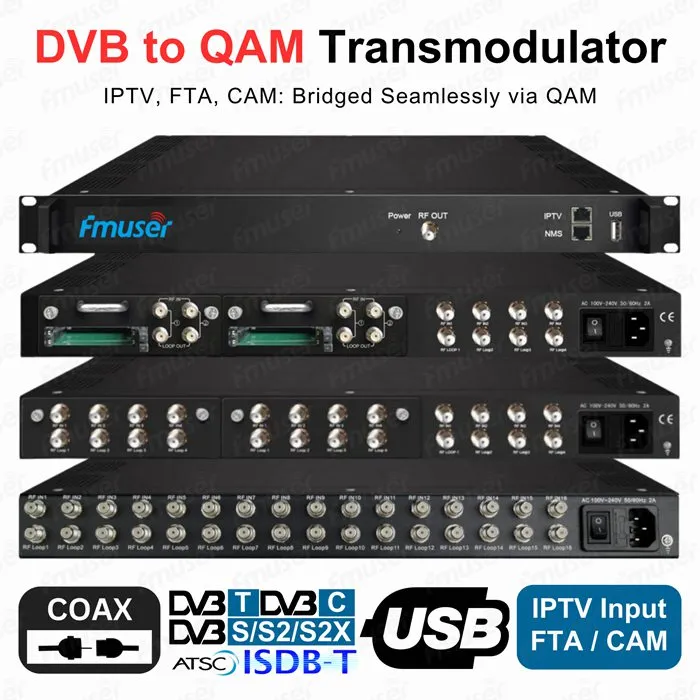
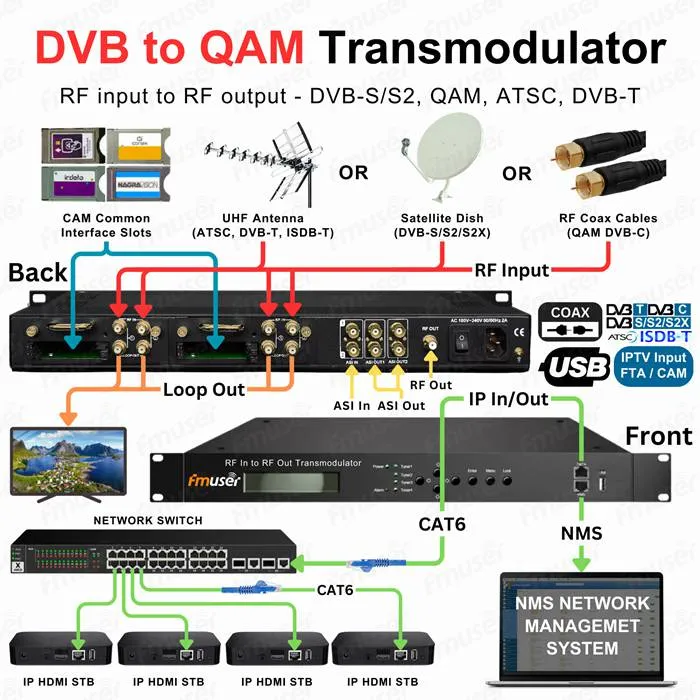
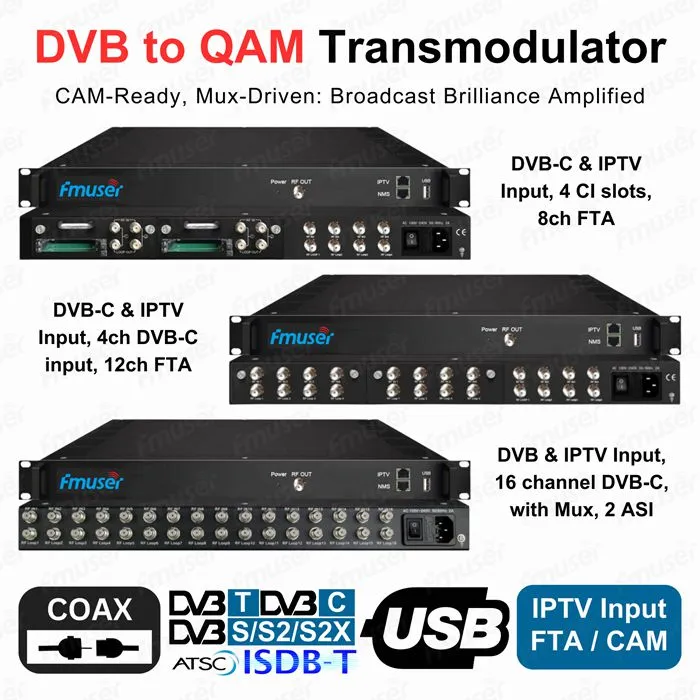
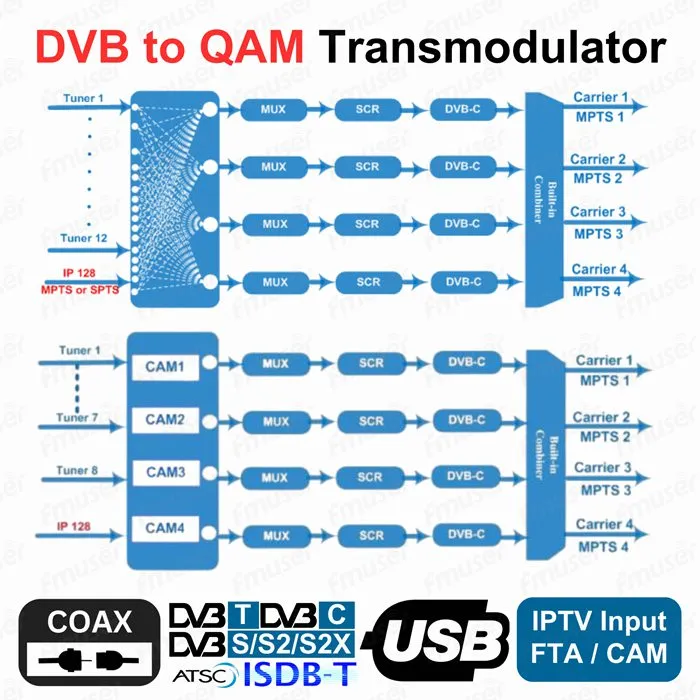
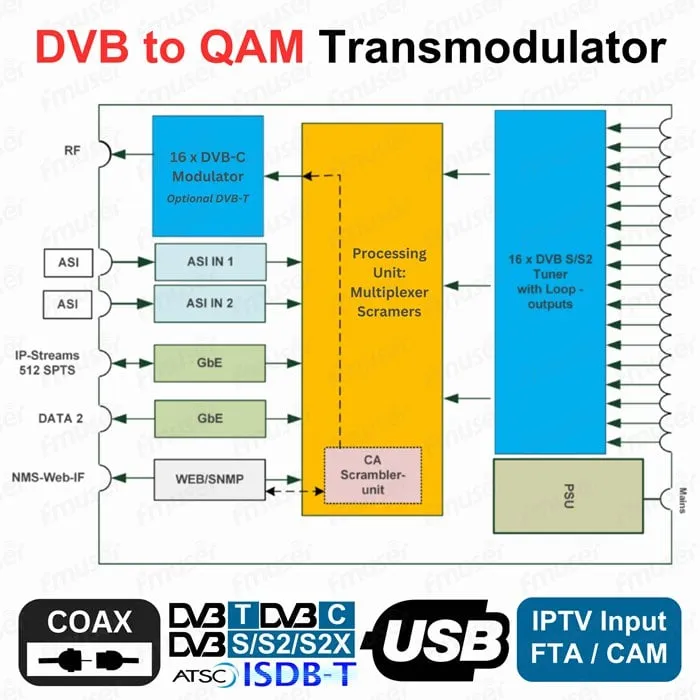

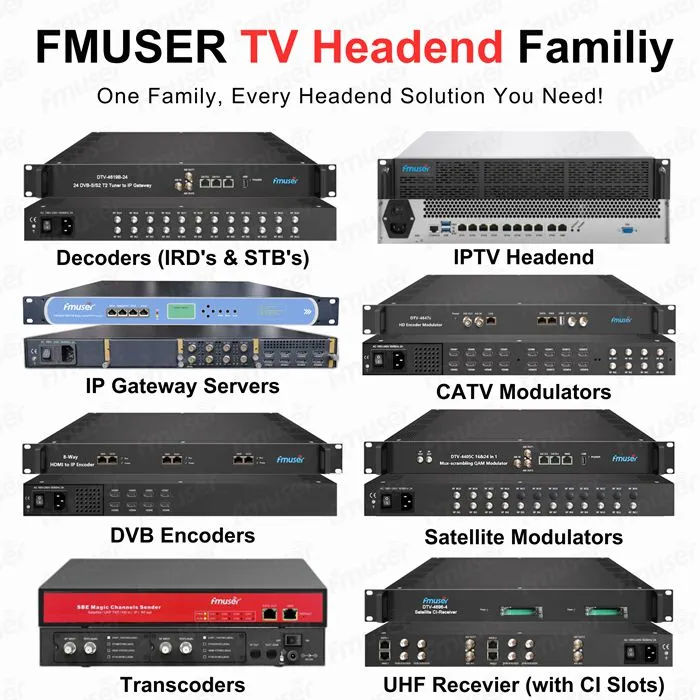
DVB to QAM Transmodulator with DVB (C/T/S/S2/S2X) / ATSC/ ISDB-T Input to DVB-C / DVB-T Output, IPTV NMS & USB Supported
FEATURES
- Input Available at: IPTV, DVB-C, DVB-T/-S/-S2/-S2X, ATSC, ISDB-, FTA/CAM Optional
- Output Available at: DVB-C (QAM), DVB-T
- Applications: All in one headend unit for SMATV systems in residential blocks, hotels, offices etc.
- Availability: In-Stock and Ship Today
- Wholesale Discount: Yes
- Shipping Method: DHL, FedEx, UPS, EMS, By Sea, By Air
- Payment: TT(Bank Transfer), Western Union, Paypal, Payoneer
Description
Transform your broadcast workflow effortlessly with FMUSER’s high-performance DVB/ATSC/ISDB-T to DVB-C (QAM) Transmodulator.

This all-in-one solution bridges the gap between RF input and RF output, converting signals across global standards (ATSC, DVB-S/S2/T/T2/C, ISDB-T) into QAM-modulated outputs for cable, IP, or ASI distribution.

Perfect for hotels, hospitals, broadcast networks, or shadow area coverage, it’s your ultimate tool for seamless signal conversion, multiplexing, and IP streaming—all managed via intuitive web controls.
Key Features & Benefits
1. Universal Signal Compatibility
Expand your audience without overhauling infrastructure—deliver satellite, terrestrial, or HDMI content to cable networks or IPTV systems.
- Input Flexibility: Supports 24 FTA tuner inputs with mixed standards (DVB-S/S2, ATSC, ISDB-T) and HDMI for hybrid setups.
- Output Versatility: Convert to DVB-C (QAM), ATSC, ISDB-T, or IP/ASI streams in 4-8 non-adjacent RF carriers.

2. Scalable Channel Capacity
Adapt to growing demands—ideal for large hotels or multi-site broadcasters needing flexible channel scaling.
- Choose from 4 to 24 channels with modular tuner configurations. Mix encrypted/FTA tuners or add HDMI sources for tailored setups.

3. Advanced IP Streaming & Multiplexing
Streamline content distribution across RF and IP networks while maintaining signal integrity.
- 128x MPTS/SPTS UDP/RTP IP inputs and 512x SPTS IP outputs for hybrid RF-IP workflows.
- ASI ports for external TS multiplexing and PSI/SI table editing.

4. Broadcast-Grade Reliability
Guarantee uninterrupted, high-quality broadcasts for critical applications like live events or emergency communications.
- MER ≥43 dB and MTBF ≥50,000 hours ensure crystal-clear output and minimal downtime.
- PCR correction and PID remapping eliminate timing errors and simplify channel organization.
5. Intuitive Management
Reduce setup time and simplify operations, even for non-technical staff.
- Web-based control + LCD front panel for remote or on-site adjustments.
- Logical Channel Numbering (LCN) and dynamic DiSEqC 1.0 LNB control.
Why Choose FMUSER? Cost & Service Advantages
✅ Lower Total Cost of Ownership
- OEM/ODM Services: Customize branding, firmware, or hardware at factory-direct prices.
- Bulk Discounts: Save up to 30% on large orders.
- Global Shipping: Optimized logistics cut costs by 15-20% vs. competitors.
✅ 24/7 Lifespan Support
- Free pre-sales consultations to design your ideal setup.
- Same-day technical support via email, chat, or video call.
- Extended warranties and spare parts at cost price.
✅ Future-Proof Investment
- Modular design allows easy upgrades (e.g., adding HDMI inputs or CI slots).
- Free firmware updates ensure compatibility with evolving standards.

Specifications
| FTA Tuners input(optional) | ||
| DVB-S/S2 | Input Frequency | 950-2150MHz |
| Symbol rate | 1~54MSps (DVB-S QPSK) 1~60MSps (DVB-S2 QPSK) 1~60MSps (DVB-S2 8PSK) 1~58MSps (DVB-S2 16APSK) 1~55MSps (DVB-S2 32APSK) | |
| FEC Demodulation | 1/2, 2/3, 3/4, 5/6, 7/8 (DVB-S QPSK) 1/4, 1/3, 2/5, 1/2, 2/3, 3/4, 4/5, 5/6, 8/9, 9/10 (DVB-S2 QPSK) 3/5, 2/3, 3/4, 5/6, 8/9, 9/10 (8PSK) 2/3, 3/4, 4/5, 5/6, 8/9, 9/10 (16APSK) 3/4, 4/5, 5/6, 8/9, 9/10 (32APSK) | |
| Signal strength | -65 ~ -25dBm | |
| Roll off | 0.20; 0.25; 0.35 (Only DVB-S) | |
| Demodulation mode | QPSK, 8PSK, 16APSK, 32APSK (Only DVB-S2) | |
| LNB polarity selection | Vol 0, 13V, 18V Selectable | |
| LNB band selection Tone | 0/22Khz Selectable | |
| Input impedance | 75 Ω | |
| FEC (Code Rate) | 1/2, 2/3, 3/4, 5/6, 7/8 | |
| Frequency Range | 30MHz-1000Mhz | |
| Bandwidth | 6Mhz, 7Mhz, 8Mhz | |
| FEC Demodulation | DVB-T: 1/2, 2/3, 3/4, 5/6, 7/8 DVB-T2:1/2, 3/5, 2/3, 3/4, 4/5, 5/6 | |
| Constellation | QPSK, 16QAM, 64QAM, 256QAM (Only DVB-T2) | |
| ISDB-T | Frequency range | 30-900MHz |
| Bandwidth | 6MHz | |
| Constellation | DQPSK,QPSK,16QAM,64QAM | |
| FEC(code rate) | 1/2,2/3,3/4,5/6,7/8 | |
| Interleave | '0,4,8,16 | |
| Guard Interval | 1/32, 1/16, 1/8, 1/4 | |
| Transmission mode | 2K, 4K, 8K (FFT) | |
| ATSC | Frequency range | 50–860 MHz |
| Input level | -34 to +40dBmV | |
| Constellation | 8-VSB | |
| Bandwidth | 6MHz | |
| Key reference specification | ATSC A/53 | |
| DVB-C | Stanard | J83.A(DVB-C,J83.B,J.83.C) |
| Constellation (QAM) | 16, 32, 64, 128, 256, 64/256 | |
| Bandwidth(MHz) | 8,6 | |
| Symbol Rate (Mbaud) | 5-7, 4.2-5.3 | |
| Multiplexing | Maximum PID remapping 180 input per channel PID remapping by automatically or manually PSI/SI: SDI/PMT/TOT/PAT/BAT/CAT/TDT/NIT Insert Accurate PCR adjusting Max numbers: 4 or 8 mux for RF and 1 Mux for 1*MPTS | |
| ASI I/O | DVB-ASI: 2 * ASI input and 2*ASI output, one for backup, 75Ω, BNC, 188Bytes MPEG-2: TS over DVB-ASI (EN 50083-9) ASI Selectable out: mirror of one MPTS | |
| IP I/O | RJ45 port: 100/1000M GbE Port,1*DATA port used for input and output IP output: 1*MPTS & 127*SPTS UDP/RTP IP input: 128*MPTS/SPTS UDP/IP TS over UDP, unicast, and multicast streaming TS over IP | |
| ASI and IP output | ||
| ASI Output | 2 * ASI output, 75Ω, BNC, 188Bytes | |
| IP Output | 1*MPTS & 127*SPTS UDP/RTP | |
| Modulation | ||
| DVB-T Modulation | Channel: DVB-T adjacent frequencies Modulation standard: EN300744 Frequency range: 96~864MHz,1Khz one step Modulation standard: EN300744 Bandwidth: 6M, 7M, 8M FFT mode: 2K, 8K Constellation:QPSK, 16QAM, 64QAM Guard Interval 1/4, 1/8, 1/16, 1/32 FEC 1/2, 2/3, 3/4, 5/6, 7/8 TS bit rate<31 Mbit/s | |
| ATSC-T Modulation | Channel: 8VSB adjacent frequencies Constellation: 8VSB Frequency range: 96~864MHz, 1Khz one step Constellation: 8VSB TS bit rate<19 Mbit/s MER≥40 dB | |
| DVB-C Modulation | Channel: DVB-C adjacent frequencies Frequency range: 96~864MHz, 1Khz one step MER ≥ 40 dB Symbol rate: 5~7 Mbaud DVB-C standard DVB-C (J83.A, J83.B, J83.C) Constellation: J.83A-6/32/64/128/256QAM; J.83B-64/256QAM; J.83C-64/256QAM Symbol rate: J.83A-5 ~ 7MSymbol/s, J.83B - fixed; J.83C - fixed Bandwidth: J.83A - 8M, J.83B - 6M, J.83C - 6M | |
| ISDB-T Modulaation | Channel: ISDB-T frequency Frequency range: 96~864MHz, 1Khz one step ISDB-T standard ARIB STD-B31 Constellation: DQPSK, QPSK, 16QAM, 64QAM Guard Interval: 1/32, 1/16, 1/8, 1/4 Transmission mode: 2K, 4K, 8K Code rate: 1/2, 3/4, 5/6, 7/8 Bandwidth: 6MHz TS bit rate<21 Mbit/s MER ≥ 40 dB | |
| DTMB Modulation | Constellation: 4QAM, 16QAM, 32QAM, 64QAM Code rate: 0.4, 0.6, 0.8 Guard Interval: 420, 595, 945 IONS | |
| GENERAL OPTION | ||
| Management | Connector: 1*RJ-45, 100/1000M Ethernet interface. Remote upgrade:via network Configuration interface: web browser ,NMS | |
| Physical and power | Power Supply: 110 ~220V Consumption 18-20W Operational temperature: 0~50°C Storage temperature: -10~70°C Humidity: 10%-90% Dimension: 430mm(W)×460(D)mm×45mm(H) Weight: 4.5kg | |
Why You Need an RF Transmodulator: Bridging Standards for Future-Ready Broadcasting
In today’s fragmented broadcast landscape, content providers face a critical challenge: delivering signals across incompatible standards like ATSC (terrestrial TV), DVB-S2 (satellite), and QAM (cable). FMUSER’s RF transmodulator eliminates these barriers, empowering you to future-proof your infrastructure and unlock new revenue streams. Here’s how it solves real-world challenges:
1. ATSC to QAM Conversion: Expand Your Cable Reach
- Problem: North American broadcasters using ATSC struggle to distribute content to cable subscribers (QAM) without costly re-encoding.
- Solution: Our transmodulator converts ATSC signals to QAM in real time, preserving 1080p/4K quality.
- Case Study: A regional broadcaster doubled its cable audience by converting ATSC feeds to QAM for local operators—no satellite uplink fees or new encoders required.
2. DVB-S2 to QAM: Satellite-to-Cable Made Simple
- Problem: Satellite broadcasters (DVB-S2) can’t directly feed cable networks (QAM), forcing reliance on middlemen.
- Solution: Transmodulate DVB-S2 satellite signals to QAM instantly, cutting out third-party distribution costs.
- Case Study: A hotel chain slashed operational costs by 40% by converting satellite TV feeds to QAM for in-room cable systems using FMUSER’s transmodulator.
3. DVB-S2 to ATSC: Integrate Satellite into Terrestrial Networks
- Problem: Satellite content (DVB-S2) can’t natively air on ATSC-based terrestrial networks.
- Solution: Convert DVB-S2 signals to ATSC for seamless integration into local broadcasts.
- Case Study: A public broadcaster enriched its lineup with international satellite channels by transmodulating DVB-S2 to ATSC, attracting 25% more viewers.

Don’t let outdated standards limit your audience. FMUSER’s transmodulator is your key to universal signal agility. Contact us today to learn more details!
CONTACT US


FMUSER INTERNATIONAL GROUP LIMITED.
We are always providing our customers with reliable products and considerate services.
If you would like to keep touch with us directly, please go to contact us



